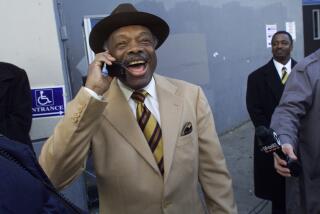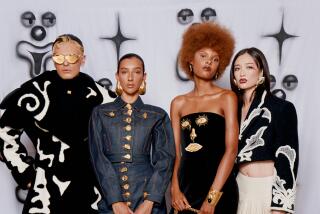Bruno Frisoni, Hollywood’s new sole man
Shoe designers Christian Louboutin and Manolo Blahnik are practically household names, but there’s a new foot soldier in town: Bruno Frisoni at Roger Vivier. No other designer right now has so many celebrities sole-struck, be it Katie Holmes or Cate Blanchett. Even Suri Cruise has her own pair of Viviers, made to measure of course, with those instantly recognizable pilgrim buckles.
In the luxury foot race at Vivier for just over four years, Frisoni is pulling ahead with the most exclusive and exquisite shoes on the planet. These aren’t just little luxuries, they are objets d’art with coral branch heels, feather-flocked vamps resembling a showgirl costume, and thorny rose embellishments. And they have price tags to match, from $525 to $20,000 for the ready-to-wear line, up to $60,000 for couture.
French designer Roger Vivier, whose label Frisoni inherits, was the most famous shoemaker in the world in the 1950s. He invented the stiletto, depending on whom you ask, created the curved “comma” heel, was the first to use plastic in footwear, designed the Belle Vivier chrome buckle-front pump that Catherine Deneuve wore in the 1967 film “Belle de Jour” and set the world on an accessories binge that has climaxed in recent years with runway models toppling off hazardous heels, and women happily shelling out $1,000 to buy them.
But when Vivier died in 1998, he did not leave a successor. So Italian luxury giant Diego Della Valle of Tod’s fame bought the name and relaunched it in 2004 with Frisoni, who has reinvented the brand with a full range of accessories (jewelry, sunglasses, bags and shoes) taking inspiration from anything and everything -- modern architecture, plastic grocery bags and Sophia Loren.
The first style he revived was the Belle Vivier, which became a celebrity favorite in all colors and heights. In stores now, the Prism heel is a more architectural take on the classic with a faceted buckle and heel. For spring, Frisoni will introduce the Torpedo flat with a flower embellishment made of eyeglass lenses. Woven plastic totes and clutches look as if they could be made out of summer-camp lanyards. And the origami-like kite heels perfectly capture the season’s geometry.
Part of the brand’s quick ascent can no doubt be credited to Della Valle, who knows better than anyone how to cuddle up to Hollywood, having recently tapped Gwyneth Paltrow to be the face of Tod’s and star in a “movie” featuring a new handbag.
There’s a similar coziness at Vivier, with celebs treating Frisoni as their personal shoe couturier. It’s an unexplored niche and so far, it’s working. Vivier is increasingly staking claim to the red carpet.
The first Vivier store opened in 2004 in Paris. In 2007, the brand opened a boutique in New York. Sales have been growing steadily, reaching $13.9 million for the first half of this year, according to Women’s Wear Daily. Next up? Bal Harbor, Fla. In L.A., Vivier is available at Neiman Marcus.
On a recent visit to the U.S., Frisoni took a break from his schedule -- dining in New York post-theater with Holmes, drinking Champagne with his best couture client, Suzanne Saperstein, at a private party in Hancock Park -- to have coffee in Hollywood at the Chateau Marmont.
Frisoni doesn’t hit the international social circuit very often, certainly not in the way Louboutin and Blahnik do. And he seems genuinely charmed by the attention celebrities heap on him. “They actually want you to be part of their lives,” he says.
He’s an unassuming guy who doesn’t own a TV and lists skiing as his favorite hobby. The thing he enjoys most about his job is drawing, and his sketches are so delightful he should publish them. The challenge comes when Italian craftsmen have to turn his dreams into actual designs.
“If you change the curve here, you have to change the heel there,” he says, using his hands to indicate the angle of a foot bed. “You work for two days on one stiletto.”
Where comfort is concerned, he’s indifferent. “There are shoes from the 1970s that were much higher,” he says. “It’s a matter of practice.”
The goal, Frisoni says, is to push the limits.
“That’s fashion, more and more.”
More to Read
Sign up for our L.A. Times Plants newsletter
At the start of each month, get a roundup of upcoming plant-related activities and events in Southern California, along with links to tips and articles you may have missed.
You may occasionally receive promotional content from the Los Angeles Times.







